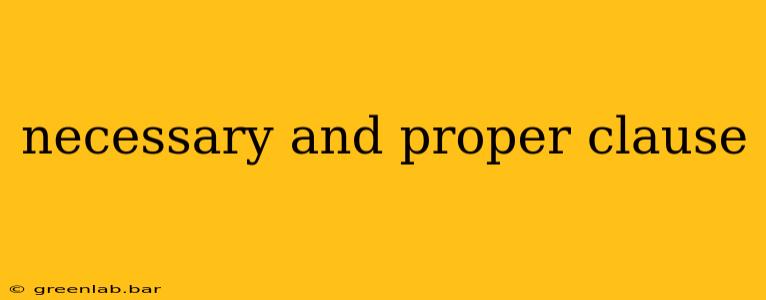The Necessary and Proper Clause, also known as the Elastic Clause, is a cornerstone of the United States Constitution, found in Article I, Section 8, Clause 18. This seemingly simple clause has had a profound impact on the evolution of the federal government, shaping its power and reach in ways unforeseen by the Founding Fathers. Understanding its complexities is crucial to grasping the dynamic relationship between the federal government and the states.
What Does the Necessary and Proper Clause Actually Say?
The clause itself reads: "To make all Laws which shall be necessary and proper for carrying into Execution the foregoing Powers, and all other Powers vested by this Constitution in the Government of the United States, or in any Department or Officer thereof."
In essence, this grants Congress the power to enact laws that are deemed necessary and proper for carrying out its other enumerated powers. It's not a grant of independent power, but rather an authorization to use implied powers to fulfill its explicitly stated responsibilities.
The Source of Debate: "Necessary" and "Proper"
The inherent ambiguity within the clause, particularly the definitions of "necessary" and "proper," has been the source of significant legal and political debate for centuries. The Supreme Court has played a pivotal role in interpreting this clause, shaping its application and impact on the balance of power within the American federal system.
The Debate over "Necessary"
The meaning of "necessary" has been a focal point of contention. Does it mean absolutely necessary, or simply convenient and useful? Early interpretations leaned toward a stricter definition, limiting Congress's implied powers. However, subsequent rulings have embraced a broader interpretation, allowing for a wider range of legislative action.
The Debate over "Proper"
The term "proper" adds another layer of complexity. What constitutes "proper" legislation is subjective and often depends on the prevailing political and social climate. This leaves room for considerable judicial interpretation and ongoing debate about the limits of Congressional power under this clause.
Landmark Supreme Court Cases and Their Impact
Several Supreme Court cases have profoundly shaped the understanding and application of the Necessary and Proper Clause.
McCulloch v. Maryland (1819): A Defining Moment
This landmark case is arguably the most significant in interpreting the Necessary and Proper Clause. The Supreme Court, under Chief Justice John Marshall, ruled that Congress had the implied power to establish a national bank, even though the Constitution doesn't explicitly grant this power. Marshall's opinion established the principle of implied powers, significantly expanding the scope of federal authority. The Court argued that "necessary" didn't mean absolutely essential, but rather "convenient, or useful" in achieving a legitimate constitutional end.
Subsequent Cases and Shifting Interpretations
Since McCulloch v. Maryland, numerous cases have addressed the Necessary and Proper Clause, leading to both expansions and limitations of Congressional power. The interpretation has fluctuated over time, reflecting changing societal values and political priorities.
The Necessary and Proper Clause Today
The Necessary and Proper Clause remains a critical component of the American legal and political landscape. It continues to be invoked in debates over federal authority, particularly in areas such as environmental regulation, healthcare, and economic policy. The ongoing tension between a strict and a loose interpretation of the clause ensures its continued relevance in shaping the balance of power between the federal government and the states.
Conclusion: A Clause with Enduring Significance
The Necessary and Proper Clause, despite its seemingly straightforward language, has proven to be a remarkably flexible and adaptable instrument of constitutional interpretation. Its evolution through Supreme Court precedents reflects the dynamic nature of American governance and the ongoing debate over the appropriate balance of power within the federal system. Understanding this clause is key to understanding the very fabric of American government.

